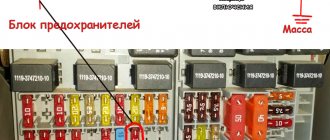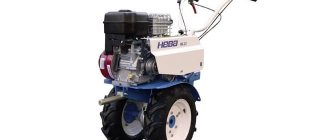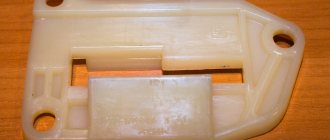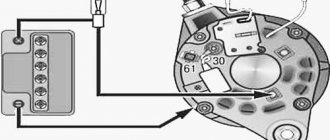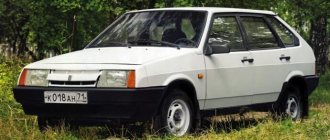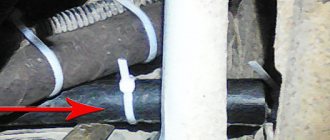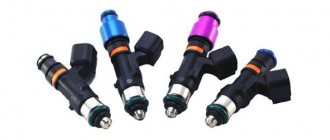Maximum speed of VAZ cars: real
What a standard VAZ engine can do and what it can’t
VAZ 2108-09-99-2115: Cx - 0.468; S (drag area) - 1.8
1100 carb. (39.7 kW/54.4 hp) - 139.35 km/h. 1300 carb. (47 kW/64.4 hp) - 147.42 km/h. 1500 carb. (51.5 kW/71.6 hp) - 152 km/h. 1500 engineers (60 kW/82.2 hp) - 159.92 km/h.
VAZ 2110: Cx - 0.348; S (drag area) - 1.93
1500 engineers 8th grade (56 kW / 76.7 hp) - 168.54 km/h. 1500 engineers 16 classes (69 kW/94.5 hp) - 180.69 km/h.
It should be noted that these figures are only suitable for a fully functional car with a STANDARD engine and gearbox, not raised, with excellent suspension and chassis (serviceable wheel bearings), adjusted wheel alignment, equal and correct tire pressure, with minimal electricity consumption (headlights , stove, radio, etc.), without “body kits” that reduce aerodynamics, an absolutely horizontal road surface and zero wind speed. Any statement to the contrary is not true in the form of scientific calculations. To reach the “chisel” speed barrier of 200 km/h. an engine power of 160 hp is required, the “ten” will need less - 130 hp. Other “control points” - 170 km/h - 100 hp (2108) / 80 hp (2110) 180 km/h - 120 hp (2108) / 95 hp (2110) 190 km/h - 140 hp (2108) / 110 hp (2110) Be realistic. The laws of physics cannot be deceived. To cover every 10 km/h at these speeds, “chisels” require about 20 km/h, “matryoshkas” - 15. Boastful statements about reaching a speed of 200 km/h in standard cars. can only make you smile. Quite a few “ten”, and certainly non-standard ones, can reach this limit, and hardware modifications range from “1000 cu.”
On topic - data from real tests from the Dmitrovsky test site, conducted by the magazine “Behind the Wheel” (No. 10, 2002, p. 44). The tests were carried out in full compliance with UNECE standards No. 68. New, serviceable factory vehicles without any modifications took part in the test. The measurements were carried out using high-precision non-contact acceleration sensors. Auto Engine Maximum speed, km/h. Speedometer error (average)
working volume, l. power kW/hp Declared by the manufacturer Measured in the test
The average speedometer error according to UNECE rules No. 39 can only be positive and not exceed the true speed by more than 10% + 6 km/h. In other words, when driving at a speed of 170 km/h. the speedometer has the right to show 170+17+6 = 193 km/h.
VAZ is authorized to announce (about tuning)
Are you tuning? Caution and caution again
In recent years, many car tuning companies have opened. New engines for front-wheel drive VAZs of 1.6, 1.7, 1.8 and 2.0 liters, direct-flow air filters, tuned exhaust systems and much more have appeared in stores.
Let's try to figure out what pitfalls await those who decide to add power to their favorite car. We asked AvtoVAZ questions, and this is what the designers said.
The first thing that the “tuners” suggest is to increase the engine size. The standard 21083 (2111) block can be inflated to 1600 cc by increasing the piston stroke. This will require not only a new crankshaft, but also shortened connecting rods. They are made from standard ones by “shrinking”, that is, shortening. This is what athletes do. The question immediately arises about accuracy and quality. is unlikely to keep the connecting rod height within specified tolerances. As a result, different cylinders may achieve different compression ratios. It is even more difficult to ensure parallelism of the lower and upper axes of the connecting rod heads, and here the slightest inaccuracy will lead to rapid wear of the cylinder. VAZ produces the following engines of increased power Index Volume, cc. Cylinder diameter, mm Stroke Compression ratio Power, kW HP
The so-called “high block” 21084 (1600) is produced by OPP VAZ. It is about 2 mm higher, with an original crankshaft (that’s what “tuners” use) and standard connecting rods.
If you bore the cylinders to 84 mm, you can get a volume of 1650 cc. But boring is fraught: you can run into hidden pores or microcracks in the “meat” of the block. The cylinder vibrates while the engine is running, and a crack invisible to the eye can grow, a little more - and hello to the engine.
Any engines not listed on the plate - both installed on new machines and lying on store shelves - were manufactured by small companies that do not at all guarantee quality.
The engine “breathes” air, because gasoline will not burn without it. This means that after increasing the engine capacity, modification of the carburetor or injection is simply necessary, otherwise the previous tuning will be of little use. The carburetor will have to be specially adjusted to the volume, and so will the injection. The factories do not produce ready-made ones: everything that is on sale is homemade. Two carburetors are a necessary measure to provide more mixture. They also require their own characteristics of vacuum and centrifugal regulators. There is simply nowhere to get them (they are selected based on the detonation reserve of a particular engine), and therefore craftsmen leave standard ones. The danger here lies in the possibility of glow ignition, which means accelerated wear of the motor, or even its destruction. With an injection machine everything is simpler: witchcraft with the control program can add 3-5%, and no more!
The result of all engine modifications is very doubtful. The service life of the motor is inversely proportional to the quality of the work performed, the qualifications and experience of the designers and the level of the machine park. If the compression ratio increases, the resource decreases even more. As a result, it can fall to 30, 20 or less thousand kilometers.
Z.Y. I don’t know who the author of the article is, but in order not to violate his rights, I say that it’s not me =) It was only edited by me, because the most interesting thing in my opinion is the data on the true dynamics of AvtoVAZ products, the second half of the sad vomit about anti-tuning was not included copy-paste zone;) Z.Z.Y. I got into about the engine anyway
Noise in the gearbox (Gearbox) is a fairly common “disease” of domestic cars that many drivers encounter. Today we will try to figure out why noise occurs in the VAZ 2109 gearbox, what are the causes of gearbox malfunctions and how to eliminate them.
Many car owners face the problem of noise and hum coming from the gearbox. This is especially true for VAZ cars that were produced 10 years ago or more. During this time, the “mechanics” (manual transmission, manual transmission) fulfills its service life, and, accordingly, the first problems begin to appear.
VAZ 2109 car
The main malfunctions of manual transmissions include:
- loosening or failure of the gearbox drive cable;
- failure of the gearbox rod;
- breakdown of the locking mechanism;
- failure of the gear shift fork.
What exactly is making noise and why?
Let's try to understand this issue. The main causes of noise coming from the gearbox are:
- improper operation of the gearbox, in particular the use of counterfeit transmission fluid purchased on the black market and operation of a vehicle with a non-working clutch;
- poor quality of gearbox components;
- maximum service life of manual transmission;
- unskilled technical work on diagnostics and repair of gearboxes.
New manual gearbox from VAZ 2109
In addition, the main malfunctions that can result in noise in the gearbox are:
- sudden difficulty switching on speed: in order to engage one or another gear, the driver will sometimes need to move the gearbox lever several times to the neutral position with the clutch depressed;
- The box automatically switches off the car’s gear while driving;
- Transmission fluid may leak from the gearbox.
It should also be noted that the VAZ 2109 gearbox can make noise in various conditions: at neutral speed, while shifting gears, or simply while driving at a certain speed. And each of these noises can indicate a different malfunction of the box.
Lada Sagona 21099 1987 – 2016
Lada 21099 automatic transmission guarantees reliability, controllability, mobility and safety of your car on the roads. Original and branded spare parts are always available in warehouses at reasonable prices.
However, speaking of repairs, even more important for driving safety is regular maintenance and timely repairs, subject to vehicle maintenance regulations:
- works well,
- does not lose its performance over long runs,
- more reliable and safer to operate
We make it easy to keep your car in good condition and provide great deals on our entire range of parts. Everything you need for service and repair can be found right here in our digital warehouses. Instead of endlessly searching for a retail auto parts store near you that doesn't necessarily have the parts you need, just pick up the phone and we'll deliver the auto parts you need to your door.
The main emphasis when selecting spare parts is based on the company’s experience.
It is profitable and safe to buy from us for a number of main reasons:
- Autocompas.ru is one of the leading online stores of auto parts, with daily traffic on the site of more than 30,000 people,
- Certified and reliable suppliers provide a full range of auto parts within access to their warehouses,
- The system has more than 500 suppliers and manufacturers who regulate prices with an eye on competitors and strive to make their goods more profitable to purchase.
Why look for Automatic transmission Lada 21099 somewhere else, wasting time? We have competent staff, payment, delivery and support services.
VAZ 2109 gearbox VAZ 2108 | VAZ 21099 | VAZ 2113 | VAZ 2114 | VAZ 2115 installation | buy | Replacement of manual transmission of VAZ of all modifications, replacement of clutch, Moscow
Artem Vadim 8 925 675 78 75
Your transmission will be overhauled within 2 hours in your presence. The cost of the bulkhead is 4000 rubles. + spare parts due to wear. Removing and installing the box on a car – 2000 rubles.
ATTENTION: for your convenience, there is a service - express replacement of a VAZ 2109 - 2115 class gearbox. When there is no time to wait for yours to be overhauled, or repair is impractical - the cost of spare parts exceeds the cost of the unit itself, we will offer to replace it with a similar one restored by our mechanics and fully prepared for operation.
Prices for replacing manual transmissions of the VAZ 2109 family are fixed and are indicated on the condition of the entire housing and gear unit. In the event of a defect in one of the parts of the housing, the gear block of 1-2, 3-4, 5 gears or the main pair, the cost of this part is added to the cost of exchange - 2000 rubles. The work takes from 1.5 to 2.5 hours.
Eliminating noise
Let's look at the signs and corresponding breakdowns of the gearbox in the VAZ 2109
| Signs |
Replacing the drive shaft bearing
If you decide to repair the drive shaft bearing yourself, then for this you will need a hammer, a vice, and a bearing puller. Let's start the repair:
- First you need to dismantle and disassemble your gearbox;
- then we take the drive shaft and clamp it in a vice. Attention! The vice must have soft metal pads;
- the rear bearing must be pressed using a special puller;
- then turn the shaft over and compress the inner race of the primary bearing in the same way;
- Now you need to push the rear bearing all the way onto the shaft. This is done using a metal mandrel and a hammer;
- the same operation must be done with the inner ring of the front bearing.
Add oil
If you decide to fix the noise problem by adding transmission fluid to the box, then prepare new manual transmission oil and some rags in advance:
- we find the dipstick for monitoring the fluid level in the box - it is located in the engine compartment on the left side, next to the battery;
- take out the dipstick and wipe it with a rag;
- then insert the dipstick back all the way and pull it out. The transmission fluid level should be somewhere between o and “Max”;
- if you see that there is less oil than necessary, then take a new one and fill it through the hole to check the level to o.
Replacing locking rings
To replace the rings of the locking mechanism, perform the following steps:
- remove and disassemble the gearbox;
- we find the blocking device;
- We see blocking synchronizers on it: you need to visually assess their condition. If fragments are visible on the rings or they themselves have expired their service life, then they need to be replaced;
- We put the box back together and put it in place.
If the hum in the manual transmission appears as a result of wear on the rings, then when they are replaced, the extraneous sounds will disappear.
Replacing the synchronizer clutch
Here you need to stock up on clutch and patience in advance:
- Having disassembled the gearbox, you need to remove the secondary shaft synchronizer;
- To get to the clutch, the synchronizer must be completely disassembled. Be careful - the parts are very small and can be easily lost. The clutch is a small ring on the inner diameter of the synchronizer;
- Having disassembled the synchronizer, check all its components for mechanical damage. If the springs are too stretched, then it is also better to replace them with new ones, but you need to buy a complete repair kit in advance;
- before installing the clutch in place, lubricate it, as well as all other synchronizer components, with engine oil;
Clutch adjustment
Incomplete disengagement of the clutch is “treated” by adjusting it:
- The clutch pedal must be pressed to the floor all the way and a meter or ruler should be placed next to it, one end of which should also be rested on the floor. Then you need to fix the value at the center of the pedal;
- now release the pedal and in the uppermost position mark the number of centimeters to it from the floor;
- then slowly press the pedal with your hand and mark the place where the clutch begins to provide resistance for further pressing;
- the amount of free play is the same distance from the pedal position until the moment the clutch begins to exert resistance;
- Now open the hood and look for the cable that connects to the pedal. There are two nuts on it, with the help of which adjustment is carried out;
Adjusting the clutch pedal cable
| The transmission is noisy when driving in neutral |
|
| There is noise coming from the gearbox and periodically disappears when the gears are turned on. |
|
- To increase free play, you need to unscrew the nut located inside the bracket. You also need to tighten the nut located outside;
- This is where the adjustment lies. If everything is correct, then the full stroke will be about 13 centimeters. If this indicator is significantly more or less, then the adjustment process should be repeated.
Lada 2109 'TAZICK 51rus' › Logbook › Gearbox bulkhead 2109
And naturally, the ball bearings were replaced with bearings with a metal cage, and the roller bearings were simply new
With grief, we pick out the retaining rings of the bearings with round pliers and remove the crankcase... I discovered a broken spring in the gear shift mechanism, which reduces the play of the lever and helps to disengage the gear.
I ran through all the auto stores and the search was unsuccessful ((((And of course, everyone offered to buy the complete mechanism for 1,700 rubles, diligently insisting that I had no choice, that I would still have to buy it. I even went to our production specifically for the spring GOC, in an attempt to find something similar, but alas... But to spite all the store sellers, I naturally found help on GOOGLE (I always turn to it) and found an interesting idea to install a spring from the radiator cap of a VAZ Classic. The old cap with 6ki father))) And of course she fit like her own.
The chip-catching magnet at the bottom of the crankcase resembled a small hedgehog)))
After a cloth with some spray, he became just a square (((And I wanted to keep him as a pet)))))
The mechanism was removed, the shafts were taken out. The entire inside was cleaned and washed with diesel fuel and the inside became like a new gearbox)))
I changed all 5 synchronizers on the secondary shaft, and read somewhere that the larger the gap between the transmission gear and the synchronizer, the easier it is for the synchronizer to stop the gear to engage the latter... Since the clutches and gears were not worn out, I did not change them. Everything is neat and with Murzilka we put everything back as it was. Well, where would we be without jambs? And these were found when I tried to insert the shift fork into the clutch of the 1st and 2nd gears... After a whole day and night of thinking with a book, remembering that I had assembled it wrong, and only when I woke up in the morning it dawned on me that the clutch was mounted on the shaft with the wrong side. Having disassembled and reassembled the shaft very carefully, I installed the fork... Aaaand... just like a balm for the soul, everything fell into place))) THE INSTRUCTION AT THE END OF THE BOOK INSTRUCTIONS LOOKED ME INTO A DEAD END! “There SHOULD NOT BE ANY EXTRA WORK! Having examined everything around on the table, I found the same magnet that was a hedgehog...(((I had to take it apart again so that it would grow and become a little hedgehog again after 10 years))) Together with my friend Denis, we halved and put the box back together in 15 minutes)))
Video “Repairing a gearbox in a VAZ 2109”
This video describes a complete step-by-step repair of a VAZ 2109 gearbox with your own hands at home.
Did you like this video? What can you tell us about the gearbox of the VAZ 2109? Share your experience with our readers!
- Year of manufacture: 1987
- Body type: Hatchback
VAZ 2109 (popularly called “nine”) is a Soviet front-wheel drive vehicle of group II small class in a hatchback body. The model was developed and mass-produced at the Volzhsky Automobile Plant from 1987-2004.
From 2004, cars (VAZ-21093) until the end of 2011 were assembled from vehicle kits at the Ukrainian enterprise ZAZ. This vehicle is also a five-door version of the VAZ-2108 in the Lada Sputnik model division. You can still buy this car on the used car market today. The entire Lada model range.
How to replace the oil seal
If you detect an oil leak from the gearbox, carefully inspect the crankcase.
The leak will reveal itself. Lubricant usually leaks out through the CV joint seals and rocker panels. In the latter case, to replace you will need to perform a number of actions:
After replacement, install the boot. Assess the condition of the cardan: if it has too much play, it will need replacement. After carrying out all the work, be sure to check that the speeds are turned on correctly.
Car history
Towards the end of the 1980s, AVTOVAZ decided to fill the empty niche of comfortable and versatile family models with the VAZ-2109 car. The fact that the debut domestic mass-produced front-wheel drive car appeared at the Volga Automobile Plant was a significant event not only for the Volga residents, but also for the entire Soviet automobile industry.
It’s a little symbolic, but the start of production of the G8 coincided with a significant event that was celebrated in the fall of 1984 - the 60th anniversary of the automobile industry of the Union of Soviet Socialist Republics. After two years, the original assembly line of the car plant in Togliatti produced a pilot batch of 159 Nine models.
The new version of the “chisel” inherited all the technical innovations from the older model and was able to instantly gain the respect of car lovers. Among all the points, the most important was the “rational” number of doors. However, despite this, a three-door version entered mass production. The logical question arises, why?
Because in a state where personal transport was considered a luxury, and happy car owners felt the transport difficulties of their relatives and friends, the standard 3-volume sedan version was more suitable to the needs of drivers. For a long time, all Soviet mass-produced cars were produced in just such a body.
More productive station wagons, which were produced in small quantities, began to be sold only towards the end of the 1960s, and they were considered in great short supply. There was not a word about other versions of the body: directors of automobile enterprises did not even risk conducting experiments, objectively believing that these programs would not be positively received “at the top.”
Appearance
From the outside, the VAZ-2109 is an evolution of the Soviet car. Here you can notice the transition to rectangular body lines, which are clearly distinguished by the bow headlights, which are shaped like a trapezoid, as well as a flat-shaped radiator grille and a slightly inclined hood. It was decided to place the turn signal lights on the long front fenders.
After some time, hydraulic headlight range control began to be installed on all “nines”, and some vehicles had a brush headlight cleaner. In 1989, the debut restyling of the “nine” exterior took place, which consisted of a transition from small front wings to longer ones. The most dubious component in the exterior of the G8 and VAZ-2109 was the so-called nasal mask.
It was a fairly complex type of body part, which was adjacent to the hood and wings installed in front. The combined mask area had a beak that protruded forward of the radiator trim. Block headlights were installed on the sides of this unusual structure. Such a pile of elements reduced the already slight elegance of the Soviet car, and the clear lines connecting the cladding to the wings looked unpleasant.
We decided to use only a solid wing, without any “tricks,” which improved the appearance of the VAZ 2109. After this, they installed a new grille, which had two longitudinal stripes in a large frame. After some time, they began to use a new version, consisting of 3 massive stripes, devoid of any frame.
VAZ-2109 with an updated radiator grille
The side part has the same straight lines of doors and roof, wheel arches and average ground clearance. “Nine” is very similar to its predecessor, the VAZ-2108, which was nicknamed “chisel”. The Soviet hatchback has the same nose shape. Unusually large doors and a thick central pillar add “sporty features” to the model.
On the “nine”, the width of the doors installed in front was reduced from 1,264 to 1,025 millimeters. Thanks to this, the design team was able to incorporate rear doors into the side of the body, the width of which is 885 millimeters. The rectangular rear lights are limited by the line of the luggage compartment lid, which also has a sharp transition at an angle to the roof.
The fifth door received a rear window with a wiper, and the bumpers, along with the side skirts, were made of black plastic (there is a similar bumper in front). The design of the VAZ 2109 has a certain swiftness of lines, but it is very far from a sports car.
Here the developers placed great emphasis on the more practical aspects of the vehicle. When 1987 arrived, the new model mastered the production of plastic gas tanks, which were much lighter and easier to assemble than others. VAZ-2108 and VAZ-2109 already had gas tanks made of steel and plastic.
It is worth admitting that after a while they decided to abandon the production of plastic tanks, as there were problems with the permeability of gasoline vapors.
Interior
The interior decoration of the VAZ is reminiscent of the minimalism of the 1980s. The instrument panel and dashboard create an almost right angle. There are only 3 types of panels: “low”, “high” and “European”. If we talk about the quality of the plastic used as finishing, then it is far from ideal.
Of course, by installing plastic in the interior of the Nine, it was possible to reduce the weight of the car, but on the other hand, it deprived VAZ cars of that touch of luxury that the Zhiguli of the classic division is remembered for. If you look at it differently, the ergonomic level is not bad, so you don’t have to be distracted from driving the vehicle on the road.
This was partly achieved through the compact arrangement of controls. Inside the steering wheel there is one curved cross member with a horn button. Airbags are not provided by the factory. In general, the interior of the VAZ-2109 is purely practical with claims to the level of comfort.
Despite the laconic “low” instrument panel, it is quite comfortable. Although many liked the high panel 2109. The seats installed in front received headrests. In addition, the front seats have upper seat belt attachment points that are height adjustable.
The elastic seats provide good body support. But a tall driver will lack the choice of adjusting his seat in the longitudinal plane. The rear sofa, although designed for three passengers, can only accommodate two people comfortably.
Do not forget that their height should be no more than 175 cm. The luggage compartment volume of the Soviet hatchback is quite modest 270 liters of usable space (the more practical platform version already received 400 liters).
Backstage adjustment
There is nothing complicated in the procedure; you can do it yourself, but you will have to run from the pit to the salon.
Yes, it is advisable to do this work in a pit or overpass. You need to act approximately according to this principle:
By adjusting the position of the gearshift rocker, you will notice that when the lever is installed in the middle, neutral speed will be engaged. When turning on the fifth gear, the lever should not catch the passenger seat, and when moving in reverse, the driver's seat should not interfere with the movement of the lever.
Technical characteristics of VAZ 2109
Engine
In the role of motors, domestic engineers used various power plants with different volumes and power. The very first Soviet-made models came with a 1.1-liter engine.
The basic version of the “nine” was equipped with a 4-stroke, eight-valve, four-cylinder power unit of the “eight”, the displacement of which was 1,295 cubic centimeters. This “engine” developed 64 horsepower at 5,600 rpm. Peak torque (94 Nm) reached after 3,400 rpm.
The speed limit was 148 kilometers per hour. The first hundred was reached in 16 seconds. Such a modest engine consumed about 8.7 liters per hundred kilometers in city mode and 5.7 liters outside the city.
Option 21093 already has a carburetor engine 21083. It has a volume of 1,499 cubic centimeters. Maximum power of 69 “horses” is achieved after reaching 5,600 rpm. The maximum torque is 106.4 Nm already at 3,500 rpm. The Soviet hatchback can accelerate to 155 kilometers per hour, and the first hundred is reached in 15 seconds.
It is logical to conclude that as power increases, gasoline consumption also increases. So, in the city this figure remains at 8.6 liters per hundred kilometers, and on the highway it drops to 5.9 liters per 100 kilometers. The VAZ 2109 carburetor was called “Solex” and was a new, more economical model.
The most compact is considered to be the 1.1-liter engine, developing only 54 “horses”, which were available at 5,600 rpm. Maximum torque of 79 Nm is available at 3,600 rpm. The maximum speed does not exceed 155 kilometers per hour, and fuel consumption in combined mode is about 6.7 liters per 100 kilometers.
In addition, later they began to produce the VAZ 2109 engine with an injector. It received the index 211180 and was installed in the VAZ-21093i and 1.5 liter volume. This power unit is capable of producing 72 horsepower, available at 5,600 rpm.
Peak torque of 118 Nm is available at 2,800 rpm. For every 100 kilometers, the fuel consumption of the VAZ 2109 is 8.0 liters in the city and 5.8 liters on the highway.
Which box is suitable for VAZ 21099?
It is obvious that the gearboxes installed on cars of the VAZ 2108-99 family (including four-speed ones) are completely interchangeable.
You can also put a box with a VAZ 2110, VAZ 2114-15 - in cases where it is installed with an injection eight-valve VAZ engine.
But when installing these units on a VAZ 21099, you will also have to replace:
- clutch cable or release bearing fork;
- starter - on these cars it has two rather than three mounting points and an armature bushing installed in the front cover.
In addition, nowadays you can buy a “sports” gearbox with shafts, the gears of which have different gear ratios, and such boxes are produced with different rows - for city traffic and for driving on the highway.
Price and options
The “nine” did not have a special level of comfort, so there is simply nothing to describe to a greater extent. Even then, it was in many ways superior to foreign cars. But the domestic hatchback was distinguished by its maintainability and the presence of the necessary parts.
The steering wheel did not have a hydraulic booster, so you had to physically work hard. There was a standard heater, a simple steering wheel and standard seats with seat belts installed.
It was possible to adjust the external mirrors from the interior using a mechanical lever. Today, the VAZ 2109 can only be purchased on the secondary market. Usually the price tag for this car is low, so you can buy a car on the go from 60,000 rubles.
Gearbox oil drain
First of all, drain the oil from the box. If you do not know how to remove the gearbox, then use the following instructions:
- Place the car on a flat surface
- We place wheel chocks on both sides under the rear wheels.
- Disconnect the car.
- The mounting bolts are unscrewed from the crankcase and its protection is removed.
- The ground wire connected to the crankcase is unscrewed.
- Unscrew the nuts on the clutch cable.
- Completely remove the clutch cable. We disconnect it from the box.
- Remove all wires from the starter.
- We remove the starter. To do this, unscrew the bolts that hold it in place.
- The drive rod, which switches speeds, is disconnected from the hinge.
- Disconnect the speedometer and cable that drive it.
- Unscrew the bolts and nuts securing the rod.
- The hinge pin is removed from the strut arm.
- The suspension joint and steering knuckle are separated.
- The CV joints are removed.
- The shield is removed.
- The box is attached to the engine with bolts. We unscrew them.
- We remove the box.
We will prepare a gearbox switching diagram in advance.
Owner reviews
Despite the rather outdated model, appearance and low dynamic performance, as well as the low level of comfort, many motorists speak quite well about the “chisel”. I am pleased with the simplicity and inexpensive maintenance. Parts can be purchased for the best possible price, and also at a flea market. You can repair it yourself. The car is ideal for tuning.
The unpretentiousness of the car is known to many. Positive reviews include fairly acceptable fuel consumption, at the level of 8-10 liters in the combined cycle. Summer residents can especially be pleased with the good ground clearance, which allows them to confidently drive over uneven surfaces and not be afraid of bumpy roads.
It’s bad that there is no hydraulic power steering, so you have to make physical efforts to control the car, especially while standing still. Inside, people can comfortably fit only in the first row of seats. For the second row there is not much free space left in the legs and above the head. It’s not very comfortable for the three of us to sit, and the transmission tunnel running in the center clearly causes discomfort.
According to reviews from VAZ 2109 owners, the hatchback’s heater works strangely; at first the interior is filled with cold air, and only then warm air begins to flow in. The quality of the interior is very mediocre, the plastic is cheap, you can hear crickets everywhere, and there are noticeable large gaps between the panels. The power unit very often lacks power, so you have to spin the engine up to 4,000 rpm.
If desired, it would be possible to install air conditioning, but the engine is very weak, so the question disappears. Safety is also far from ideal, so if there is a serious accident, at best you can get away with injuries. Only recently, domestic cars began to be equipped with many systems that ensure safety, but this, of course, did not affect the VAZ 2109 in any way.
Advantages and disadvantages
- Inexpensive Soviet-made car;
- Front-wheel drive can certainly be considered an advantage;
- Acceptable ride height;
- Good dynamics, high speed, pleasant handling and sufficient stability on different surfaces;
- Heating and ventilation cope well with their tasks and supply air to several points at once, which improves the uniform distribution of thermal air throughout the cabin;
- Acceptable fuel consumption;
- Ideal for tuning;
- Availability of spare parts and good maintainability.
- Corrosion of metal;
- The appearance is clearly not for everyone;
- A small resource of some details;
- Mediocre sound insulation of the cabin;
- Low equipment;
- There is very little free space, especially for rear passengers;
- Small luggage compartment;
- Poor maneuverability;
- Poor quality interior;
- Low level of security;
- The power unit clearly lacks power.
Let's sum it up
After getting acquainted with the Soviet hatchback VAZ 2109, conflicting feelings remain. On the one hand, this is a car that boldly stepped into the future, because previously there were only rear-wheel drive models, but on the other, the quality of the Soviet automobile industry is lame in many respects and is significantly inferior to foreign cars.
However, among other things, the car is ideal for beginners who are just learning to drive, since the car can be purchased for a “mundane” price tag. On top of that, hatchback parts can be found everywhere and they are not that expensive, which is a definite plus. You can carry out repairs yourself in your garage, which also simplifies a lot.
The car looks quite controversial, so it has both supporters and opponents of its exterior. It is clear that there is not much free space inside, especially for rear passengers, and the luggage compartment volume clearly leaves room for improvement.
Also, the quality of the materials and plastic used for finishing is very poor, “crickets” can be heard everywhere and gaps between the panels are visible. The seats themselves are not the most comfortable, so during long trips you may feel tired. Based on crash tests, the hatchback is a dangerous car.
The car clearly lacks power, so you almost always have to turn off the engine of the VAZ 2109. But do not forget that the car is many years old and at its age it was very popular in the Soviet Union, as there were queues for it.
Yes, the model did not receive air conditioning, hydraulic power steering, etc., but tuning enthusiasts can upgrade and create a car to suit their preferences for fairly reasonable money, making the car a unique vehicle. “Chisel” will forever remain in the memory and hearts of those who owned it, despite frequent breakdowns and low levels of comfort.
Short-throw slides for "nine"
Such designs were developed exclusively for sports models, but are widely used in production ones. Advantages of the VAZ-2109 short-stroke rocker over the standard one:
But you don’t have to buy a VAZ-2109 rocker in stores; you can make a short-shifter from a regular one with little welding skills.
To do this, cut the old rocker in two places and weld pieces of a metal plate to lengthen the arms. The main thing is for the new drawstring to fit into place, so first carefully study the drawing, which shows the locations of the cuts.
Source
